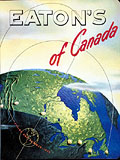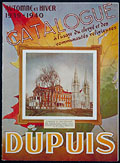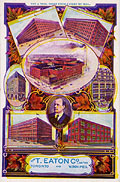Ronald Chabot: A Passion for Collecting
Interview with John Willis,
compiled by Marguerite Sauriol
"… what drives a collector is not so much
the
possibility of a reward … it is a taste for adventure."
—Ronald
Chabot
Ronald Chabot lives in Lévis, across the river from Québec,
and
owns a paving company. Originally from Saint-Zacharie in the Beauce
region, he
has been an avid collector for over 35 years. He began gathering various
objects
in 1968 at the age of 21. What got him started? One day, he saw a truck on
the
road overflowing with antiques. He figured that it was headed for the
United
States, taking those heritage objects far from their place of origin or
use.
At that moment, he decided to accumulate all kinds of things, made in
Canada
and abroad, to keep them in Quebec.
It was after reflecting on those antique or familiar objects and their
flight
abroad that he began collecting a wide variety of things. Over the past
few years,
however, he has focused more on three categories of articles: cast-iron
objects
(piggy banks, frying pans, stoves, irons, etc.); promotional items and
other
sheet metal products made by Thomas Davidson Manufacturing, and mail-order
catalogues.
This last category, the most extensive, occupies a special place in
Chabot's
collections.
Mail-order Catalogues
| |
 |
|
| |
 Eaton's Spring/Summer Catalogue, 1950. In
1950,
the company extended its sales network to every region of the country. As
this illustration shows, at the time it had several buildings in various
parts of the country. Eaton's Spring/Summer Catalogue, 1950. In
1950,
the company extended its sales network to every region of the country. As
this illustration shows, at the time it had several buildings in various
parts of the country.
|
|
| |
|
|
|
The decision to collect catalogues was not made overnight. In his early
days
as a collector, Chabot found a few here and there, and then, over the past
ten
or fifteen years, he began looking for catalogues of kitchen and wood
stoves
from Quebec. He has been collecting this type of publication "on a
systematic
basis" since the early 1990s. When he met historian Michel Lessard,
the
latter explained the role collectors play by supplying museums and
networks,
as well as the importance of catalogues, which are a very rich source of
all
kinds of information. According to Chabot, their importance stems from the
fact
that this type of publication is "a document … a witness of an
era
… a chronological record, in a way, that reflects society.
Catalogues do
not lie." He adds: "… when you look at a retail
catalogue,
you can link an object to a period in time, then you can look at three or
four
catalogues that preceded it and three or four that were published
after"
to see that styles change.
Catalogues: Collector's Items that Are
Becoming Increasingly
Popular
Chabot noted that the catalogue market has evolved over the past ten
years.
He has visited numerous antique dealers and has always openly explained
the purpose
of his search. Through those visits, Chabot has certainly helped other
collectors
understand the importance of this promotional material. Many people have
begun
looking for catalogues for various reasons. Among other things, such
publications
make it possible to establish precise dates for objects. In addition,
explains
Chabot, Christmas catalogues are essential to anyone who wants to collect
toys.
Other people who happened to keep catalogues but did not collect them
seemed
to have a good understanding of their importance and, to a certain extent,
their
value.
At the moment, therefore, a good many people are increasingly
interested in
catalogues, but the reason they collect is of little importance. Each
catalogue
is unique in some way, because it offers certain categories of
merchandise, for
example, or is more general and diversified in nature. That is one of the
reasons
Chabot is interested in certain types of catalogues.
Highlights of Certain Catalogues
| |
 |
|
| |
 Three Sacred Heart statues sold by Daprato,
1929.
The Chicago firm specialized mainly in the production of religious
articles.
This image is from its 1929 catalogue. Three Sacred Heart statues sold by Daprato,
1929.
The Chicago firm specialized mainly in the production of religious
articles.
This image is from its 1929 catalogue.
|
|
| |
|
|
|
Although Chabot has a marked preference for stove catalogues and his
only
copy featuring products made by the Thomas Davidson company, the ones that
are
most attractive, from the point of view of their graphic presentation,
were published
by two American companies, California Perfume, based in New York, and
Daprato,
a Chicago firm specializing in religious articles that were well known in
Quebec
at the time. To Chabot, the California Perfume catalogue is the most
impressive
because of the way colour is used and the fact that the articles are shown
life-size.
The catalogues he finds most fascinating are usually those from the
1910s
and 1920s, especially the sections devoted to women's clothing and
hats,
whose colour illustrations he finds wonderful. Catalogues were in fact
designed
first and foremost to attract the attention of women, of the female
consumer.
According to Chabot, the women's clothing section was longer and
more striking
than the others. Some companies, such as Dupuis Frères, included
nationalism
and the Catholic religion in their sales pitch.
|
|
| |
 |
|
| |
 Beauty products from the California Perfume
catalogue,
ca 1917. The New York firm made perfume and personal hygiene products for
adults and children. (products for the body) Beauty products from the California Perfume
catalogue,
ca 1917. The New York firm made perfume and personal hygiene products for
adults and children. (products for the body)
|
|
| |
|
|
|
|
| |
 |
|
| |
 Beauty products from the California Perfume
catalogue,
ca 1917. The New York firm made perfume and personal hygiene products for
adults and children. (products for babies) Beauty products from the California Perfume
catalogue,
ca 1917. The New York firm made perfume and personal hygiene products for
adults and children. (products for babies)
|
|
| |
|
|
|
|
| |
 |
|
| |
 Dupuis Frères Fall/Winter Catalogue
for the Clergy,
1939-40, cover featuring the cathedral of Saint-Hyacinthe. At the time,
there were a large number of religious orders in the city located on the
Yamaska River, in one of the wealthiest districts of Quebec. There is a
maple leaf in the background. Dupuis Frères Fall/Winter Catalogue
for the Clergy,
1939-40, cover featuring the cathedral of Saint-Hyacinthe. At the time,
there were a large number of religious orders in the city located on the
Yamaska River, in one of the wealthiest districts of Quebec. There is a
maple leaf in the background.
|
|
| |
|
|
|
|
To Chabot, the golden age of catalogues was between 1880 and 1915, a
period
known to historians as la belle époque. He noted that catalogues
from
that period contain very beautiful plates. However, the material
presentation
of this type of publication deteriorated during what he considers a
"period
of decadence" that began in the 1940s, during the Second World War.
At
that time, the catalogue illustrations looked like poor photocopies and
companies
focused more on the quality of the products sold. That was not the case
for all
firms, though. For example, one day, while speaking to a fellow collector
about
a certain catalogue and pointing out the quality of the paper as well as
the
richness of the images and the graphic presentation that conveyed the
quality
of the goods well, Chabot suddenly realized that the catalogue in question
was
from England.
Catalogue Collections
Chabot's collection contains several catalogues produced by
foreign
companies, including some from the United States: the Daprato and
California
Perfume catalogues mentioned above and that published by Montgomery Ward,
a Chicago
firm. He also has catalogues from France, catalogues produced by carriage
manufacturers,
and stove catalogues.
| |
 |
|
| |
 Goodwin's Fall/Winter Catalogue, 1911-12.
Located
in Montréal, the company had been founded two years previously
under the
name Rea A. E. & Co. Goodwin's Fall/Winter Catalogue, 1911-12.
Located
in Montréal, the company had been founded two years previously
under the
name Rea A. E. & Co.
|
|
| |
|
|
|
Chabot probably started his collection with a catalogue from
Eaton's
or Simpson's. He now has several thousand catalogues from department
stores
and specialized retailers such as Canadian Tire, Hudson's Bay
Company,
La Compagnie Paquet, P. T. Légaré, Goodwin's,
Bélanger
of Montmagny, Copp Brothers, a Hamilton company that sold stoves, McClary,
Gurnoy,
Obe, a stained-glass company from Montreal, and, Desjardins, a fur
company. Chabot's
collection includes about 140 Dupuis Frères catalogues, and 400 to
500
from Eaton's and Simpson's.
Chabot points out that, like the catalogues of La Compagnie Paquet,
those
published by P. T. Légaré are hard to find, especially
issues from
the early 20th century. He considers himself lucky, however, to have found
catalogues
produced by the company. A friend from the Saint-Roch-des-Aulnaies region,
whose
grandfather had been a representative of the company, had a whole series
of them
in his attic. One of the catalogues was from 1889, the early days of the
firm
when it was called Latimer et Légaré. Some copies were still
in
the shipping envelope, so they were practically new. Chabot inherited
those catalogues.
Unless you have such a stroke of luck, says Chabot, you must go to
specific
places to obtain catalogues.
Chabot's Finds
The main sources of catalogues are garage sales and flea markets, for
example,
in Saint-Romuald and Sainte-Foy. It was in Sainte-Foy that Chabot found a
box
full of Dupuis Frères catalogues. According to Chabot, the antique
dealer
practically gave him the box. One usually finds single copies of
catalogues,
or maybe two or three at a time. Chabot obtained the Daprato catalogues
from
an antique dealer who liquidated his business. The dealer had kept several
boxes
of catalogues from the Chicago company. Little by little, Chabot became
known
in the network as a collector, which sometimes made it easier to acquire
certain
objects. That is how he found himself with a considerable number of
catalogues
and collector's items. All he needed was a place to put
everything.
Storing the Catalogues
The objects collectors accumulate end up playing a very big role in
their
lives because collecting is a passion: "If you speak to
collectors,"
explains Chabot, "you'll find that they are necessarily
passionate
about what they do … A collection is like the third member of a
couple."
Eventually, the objects accumulated literally invade the home so Chabot
had his
basement and one other room redone to preserve his treasures. He also
employs
specific storage techniques. The cast-iron objects made by Thomas Davidson
are
in airtight plastic containers. The catalogues are stored vertically,and
each
one has been placed in an acid-resistant plastic envelope to protect it
from
humidity, light, and rodents. In addition to doing an inventory of the
Simpson's,
Dupuis Frères and Eaton's catalogues, Chabot established a
filing
system. He also has a vast collection of postcards, which he organized
according
to region and placed in albums.
The Collectors' Network
For several years, Chabot systematically purchased everything he found,
even
if it meant he had duplicates or triplicates of objects. He was thus able
to
supply items to universities, museums, and friends. He also lent
catalogues to
researchers, including one who specialized in traditional Quebec
architecture
and another who was researching the material culture of Quebec. He also
supplied
Dupuis Frères catalogues to the Canadian Postal Museum and Josette
Dupuis-Leman,
descendant of the founders of Dupuis Frères. Some pages from the
store's
catalogues were reproduced in a book she wrote entitled "Dupuis
Frères,
le magasin du peuple"; it was published in 2001 by
Stanké in
Montréal.
For the past few years, antique dealers and collectors have met at an
important
annual event that usually takes place in Drummondville but was held in
Saint-Hyacinthe
in April 2003. In addition to that event, which is not a place for
exchanging
objects, there are informal get-togethers, as well as meetings of the
various
collectors' associations.
Conclusion
It is not easy to start a collection. "Ideally, you should have
help,"
says Chabot, and not all collectors are willing to share information. Lack
of
experience, he adds, is another problem that has to be considered. It
takes several
years' experience in a particular field to be able to correctly
determine
the quality of an object. "Sometimes you get rid of things you
should have
kept or you buy things that you shouldn't have." With the
postcards,
for example, it took Chabot about five years to get the feel of it, to be
able
to gauge the nature of "a beautiful postcard." He began
collecting
cards that featured storefronts, store interiors, commercial streets and
businesses,
promotional postcards, etc., and eventually ended up with 1500 to 2000
cards.
|
|
| |
 |
|
| |
 Lamontagne Limited promotional postcard. The
Montréal
firm made leather goods, including suitcases, trunks, and equipment for
horses. Lamontagne Limited promotional postcard. The
Montréal
firm made leather goods, including suitcases, trunks, and equipment for
horses.
|
|
| |
|
|
|
|
| |
 |
|
| |
 Postcard featuring various Eaton's buildings.
This
card also has an effigy of John Craig Eaton, who was the company's
president
at the time and who had control of the company from 1907 until the
beginning
of the 1920s. Timothy Eaton opened his first store in 1869 in Toronto. It
was the precursor of the mail-order catalogue. By the end of the 1920s,
Eaton's had two stores (the second in Winnipeg), two factories, and offices
in Europe. Postcard featuring various Eaton's buildings.
This
card also has an effigy of John Craig Eaton, who was the company's
president
at the time and who had control of the company from 1907 until the
beginning
of the 1920s. Timothy Eaton opened his first store in 1869 in Toronto. It
was the precursor of the mail-order catalogue. By the end of the 1920s,
Eaton's had two stores (the second in Winnipeg), two factories, and offices
in Europe.
|
|
| |
|
|
|
|
| |
 |
|
| |
 Postcard promoting an Eaton's catalogue, 1945.
People who presented this card at the company's order office received a
copy of the new Eaton's Fall/Winter Catalogue, 1945-46. Postcard promoting an Eaton's catalogue, 1945.
People who presented this card at the company's order office received a
copy of the new Eaton's Fall/Winter Catalogue, 1945-46.
|
|
| |
|
|
|
|
In short, collectors are driven by a real passion, the
"feverishness
of finding a specific object." After collecting for over 35 years,
remarks
Chabot, "You begin to have some practical experience … you
begin
to recognize the objects, to know lots of things," and that is what
becomes
interesting. He adds that there is a taste for adventure from the outset.
His
passion for collecting has allowed Chabot to meet many historians and
people
in museums, as well as travel and discover the province. In other words,
collecting
is also a social activity.
|